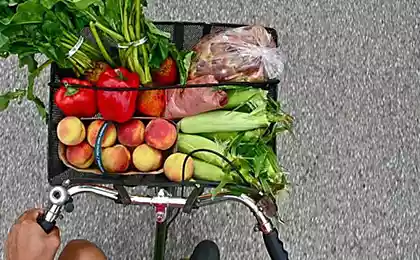668
How to teach a child to proper nutrition
In the spring, and so soon in our diet will begin to dominate the fruits and vegetables. But what if the child doesn't like them? This question will tell a pediatrician Elena Motova and, as always, will give useful advice.
Thirty eight million two hundred sixty eight thousand one hundred seventy nine
Usually problems with vegetables and fruits arise where adults do not realize how important the example is that for kids in the formation of food habits. For example, in a family where the dad feeds the "freezing" and fast food, and mom always sits on a diet, buying only low-fat foods, the child has no chance to love vegetables. He sees that daddy eats like a mother forced to feed on celery and carrots, and how much the kid talked about the benefits of fruits and vegetables, it is unlikely that he will learn it.
Why children don't eat vegetables and fruits?
Remember, in the book of Astrid Lindgren about Carlson have a Baby, a typical thin child with poor appetite? He never wants to eat, but parents are putting a lot of effort, trying to feed it properly. "Better to die than to eat cabbage" – does not give the Baby. "Cauliflower is very useful," explain the parents. The child says, "I have noticed that the only useful things that taste good". This point of view, the parents, unwittingly, formed the child, and he will get her further in life. It was not persuaded that the food can be tasty and useful.
Seventy eight million seven hundred fifteen thousand four hundred seventy four
Do not force your child to eat specific foods, and calmly and gently, not insisting, offer your child vegetables again and again, when he is hungry and ready to eat everything. And don't try at any cost to shove the "most useful" because it is simply not found in nature. Understand, these are products of the same group, they are interchangeable. Let the child eat any vegetables, fruits and berries, which he likes.
Why plant foods are important?
On the recommendation of the who (world health organization) healthy children and adults in developed countries needs to obtain vitamins and minerals naturally from foods.
The wrong strategy parents
The most common parental strategy of the power after to make or to persuade is to cheat. Disguise the healthy food that the child likes, even if it's not the best choice. Yes, right now the muffins with zucchini, carrot cake and chocolate pie with spinach will force the child to eat more vegetables! Think that in the long term the child will not learn to choose and eat vegetables and fruits, and when you are not around, he will prefer what they're used to cakes with fat and sugar. Only here the vegetables will not be in it.
Cook vegetables properly
If the child is reluctant to eat cooked or steamed vegetables, you can offer them in any other form, and even better to learn how to cook them.
Offer raw vegetables and fruits
Children who don't eat salads, happy crunchy vegetables cut into sticks, which are so good dipped in a homemade sauce such as tzatziki or milk mayonnaise. And chunks of fruit as a snack I like almost everything. A good idea is to put raw vegetables and fruits in the lunch box of the child.
Show an example: prepare yourself for a big beautiful plate of sliced fruit for an afternoon snack, or make a dessert in the form of dense fruit and vegetable juice. Not interested? Nothing, you will get more, but just this once. Convince not notation, and parental example. If you love fruits and vegetables, with pleasure choose them and buy, happy cooking and eating, your actions will be learned.
Useful tips for parents:
Source: www.gastronom.ru
Thirty eight million two hundred sixty eight thousand one hundred seventy nine
Usually problems with vegetables and fruits arise where adults do not realize how important the example is that for kids in the formation of food habits. For example, in a family where the dad feeds the "freezing" and fast food, and mom always sits on a diet, buying only low-fat foods, the child has no chance to love vegetables. He sees that daddy eats like a mother forced to feed on celery and carrots, and how much the kid talked about the benefits of fruits and vegetables, it is unlikely that he will learn it.
Why children don't eat vegetables and fruits?
Remember, in the book of Astrid Lindgren about Carlson have a Baby, a typical thin child with poor appetite? He never wants to eat, but parents are putting a lot of effort, trying to feed it properly. "Better to die than to eat cabbage" – does not give the Baby. "Cauliflower is very useful," explain the parents. The child says, "I have noticed that the only useful things that taste good". This point of view, the parents, unwittingly, formed the child, and he will get her further in life. It was not persuaded that the food can be tasty and useful.
Seventy eight million seven hundred fifteen thousand four hundred seventy four
Do not force your child to eat specific foods, and calmly and gently, not insisting, offer your child vegetables again and again, when he is hungry and ready to eat everything. And don't try at any cost to shove the "most useful" because it is simply not found in nature. Understand, these are products of the same group, they are interchangeable. Let the child eat any vegetables, fruits and berries, which he likes.
Why plant foods are important?
- Vegetable food gives us water-soluble vitamins, mineral salts, sugars and complex carbohydrates – starch and plant fibers.
- Vegetables and fruits contain a number of substances (not all of them are open, many are being studied) that perform protective functions in the body.
- Global strategy on diet stresses that an insufficient amount in the diet fruit and vegetables account for about 19% of cancers of the gastrointestinal tract and 31% of coronary heart disease.
- Modern scientifically-based dietary recommendations, such as MyPlate (USDA, 2011), it is determined that plant foods should be about ¾ of the total ration. Half of children and adult plates at the same given vegetables and fruits.
On the recommendation of the who (world health organization) healthy children and adults in developed countries needs to obtain vitamins and minerals naturally from foods.
The wrong strategy parents
The most common parental strategy of the power after to make or to persuade is to cheat. Disguise the healthy food that the child likes, even if it's not the best choice. Yes, right now the muffins with zucchini, carrot cake and chocolate pie with spinach will force the child to eat more vegetables! Think that in the long term the child will not learn to choose and eat vegetables and fruits, and when you are not around, he will prefer what they're used to cakes with fat and sugar. Only here the vegetables will not be in it.
Cook vegetables properly
If the child is reluctant to eat cooked or steamed vegetables, you can offer them in any other form, and even better to learn how to cook them.
- For example, delicate vegetables throughout cook too long, they not only lose flavor and vitamins, but acquire a undeservedly bad reputation.
- Often mothers prepare steamed vegetables without offering them no spices, no sauce, but monotonous, bland food gets old quickly.
- I think baking in the oven greatly underestimated, and in fact this method allows to achieve a more vivid taste of vegetables and saves time.
- Show imagination! So I can't say that I am a fan of cauliflower, but there are ways to cook it so that is happy: cream soup slow cooking, gratin of cauliflower, cabbage with a dressing of Greek yoghurt, or fried in breadcrumbs, but just raw or lightly blanched with any sauce — of all the wonderful things you can make from a boring vegetable!
Offer raw vegetables and fruits
Children who don't eat salads, happy crunchy vegetables cut into sticks, which are so good dipped in a homemade sauce such as tzatziki or milk mayonnaise. And chunks of fruit as a snack I like almost everything. A good idea is to put raw vegetables and fruits in the lunch box of the child.
Show an example: prepare yourself for a big beautiful plate of sliced fruit for an afternoon snack, or make a dessert in the form of dense fruit and vegetable juice. Not interested? Nothing, you will get more, but just this once. Convince not notation, and parental example. If you love fruits and vegetables, with pleasure choose them and buy, happy cooking and eating, your actions will be learned.
Useful tips for parents:
- Need to offer your child vegetables and fruits of different colors,
- Vegetables, fruits or berries have to log in almost every meal, the recommended number for adults is more than 600 g, for children – more than 400 grams every day (potatoes do not count).
- It is preferable to use local and seasonal fruits,
- Vegetables and fruits brought from afar, should be thoroughly washed.
- If the child eats 4-5 any vegetable and the same fruit, hence, no problems there. You can gradually extend the list, without pressure, quietly offering to try something new. Upset that the child does not drink juice if he likes and eats fruits, as it happened during one of my consultations, absolutely no reason.
Source: www.gastronom.ru
























